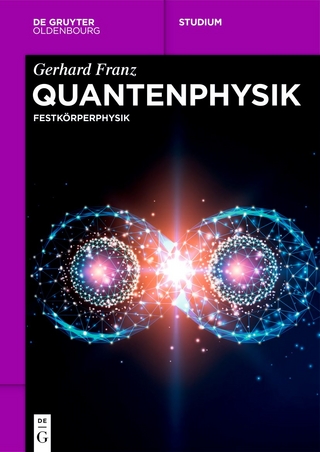
Superconductivity
Springer International Publishing (Verlag)
978-3-319-50525-1 (ISBN)
This book proposes a thorough introduction for a varied audience. The reader will master London theory and the Pippard equations, and go on to understand type I and type II superconductors (their thermodynamics, magnetic properties, vortex dynamics, current transport...), Cooper pairs and the results of BCS theory. By studying coherence and flux quantization he or she will be lead to the Josephson effect which, with the SQUID, is a good example of the applications. The reader can make up for any gaps in his knowledge with the use of the appendices, follow the logic behind each model, and assimilate completely the underlying concepts. Approximately 250 illustrations help in developing a thorough understanding.
This volume is aimed towards masters and doctoral students, as well as advanced undergraduates, teachers and researchers at all levels coming from a broad range of subjects (chemistry, physics, mechanical and electrical engineering, materials science...). Engineers workingin industry will have a useful introduction to other more applied or specialized material.
Philippe Mangin is emeritus professor of physics at Mines Nancy Graduate School of Science, Engineering and Management of the University of Lorraine, and researcher at the Jean Lamour Institute in France. He is the former director of both the French neutron scattering facility, Léon Brillouin Laboratory in Orsay, and the Material Physics Laboratory in Nancy, and has taught superconductivity to a broad audience, in particular to engineering students.
Rémi Kahn is a retired senior research scientist of the French Alternative Energies and Atomic Energy Commission (CEA-Saclay). He worked at the Léon Brillouin Laboratory and was in charge of the experimental areas of INB 101 (the Orphée research reactor).
This work responded to the need to bring an accessible account suitable for a wide spectrum of scientists and engineers.
Philippe Mangin, now Emeritus Professor, is the author of 130 papers in solid state physics: amorphous materials, thin films, magnetism, neutron scattering, rare earths. He directed during four years the "Laboratoire de Physique des Matériaux" of Nancy and for four other years the "Laboratoire Leon Brillouin" in Saclay, which is the French neutron scattering facility. He spent two "one-year-periods" at the National Institute of Sciences and Technology in Gaithersburg MD (USA), became a member of various committees in the neutron scattering field, and a reviewer for many papers (PRL, PRB, etc.). Rémi Kahn, expert in neutron scattering, worked in the bosom of the "Laboratoire Léon Brillouin" for many years; he became the leader of the inelastic scattering group, then was in charge of the support groups and finally deputy-director responsible for the Orphée reactor's experimental areas. He authored around 100 papers in various solid state physics fields: phonons, magnetic critical transitions, vortex in superconductors, molecular dynamics in liquid and ad(ab)sorbed phases.
Introduction.- 2. LONDON theory.- 3. The non-local PIPPARD equations.- 4. Thermodynamics of type I superconductors.- 5. The intermediate state of type I superconductors.- 6. Type II superconductors.- 7. Fields and currents in type II superconductors - Models of the critical state.- 8. COOPER pairs -Principal results of BCS theory.- 9. Coherence and the flux quantum.- 10. The JOSEPHSON effect.- 11. Superconducting Quantum Interference Device "SQUID".- 12. JOSEPHSON junctions in a magnetic field.
"In Mangin and Kahn's 'Superconductivity' there is an overview of the scientist who are/were involved in the discoveries connected to superconductivity. ... In 'Superconductivity' you can also read about how SQUID magnetometers work, that enable scientists to measure very small magnetic fields. The book is a well-rounded, complete and student friendly guide to superconductivity. It assumes that the reader is well acquainted with at least undergraduate physics." (AstroMadness.com, December, 2017)
"The rich contents of the major topics of superconductors are very well organized into a small volume, and are presented nicely and concisely. The physical theories are clearly explained, with the mathematical details given as appendices of each chapter, so that the reader will not get lost in the technical details. ... this book is interesting both to students and researchers in physics and mathematics who wish to know the global picture and beauty of the theory of superconductivity." (Xingbin Pan, zbMATH 1372.82002, 2017)| Erscheinungsdatum | 12.01.2017 |
|---|---|
| Zusatzinfo | XVI, 379 p. 241 illus. |
| Verlagsort | Cham |
| Sprache | englisch |
| Maße | 155 x 235 mm |
| Themenwelt | Naturwissenschaften ► Physik / Astronomie ► Festkörperphysik |
| Technik ► Elektrotechnik / Energietechnik | |
| Technik ► Maschinenbau | |
| Schlagworte | Electronic devices and materials • high Tc superconductors • Levitation in Magnetic Fields • Meissner effect • Nanotechnology and Microengineering • optical and electronic materials • other manufacturing technologies • Physics • Physics and Astronomy • Quantum Critical Behavior • Quantum Criticality • Strongly Correlated Systems, Superconductivity • Superconductivity Book • Superconductor Quantum Interference Device • Type II Superconductors • Zero Electrical Resistance |
| ISBN-10 | 3-319-50525-4 / 3319505254 |
| ISBN-13 | 978-3-319-50525-1 / 9783319505251 |
| Zustand | Neuware |
| Haben Sie eine Frage zum Produkt? |
aus dem Bereich


